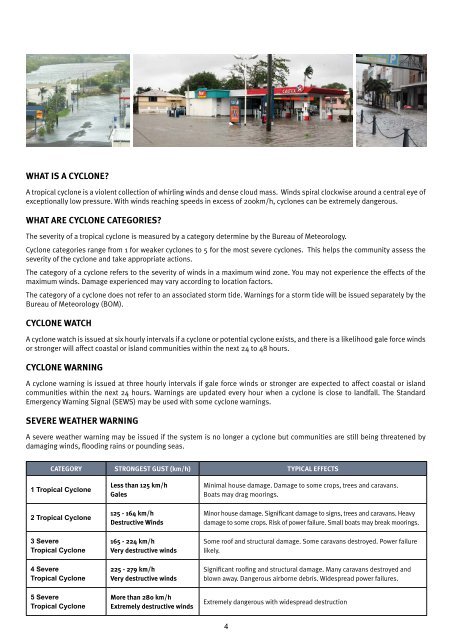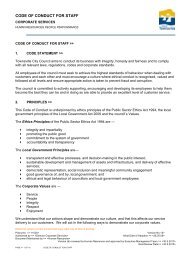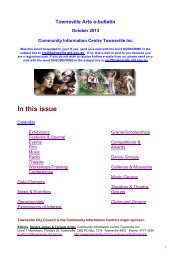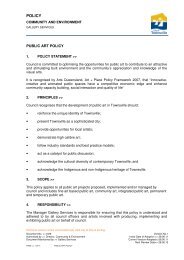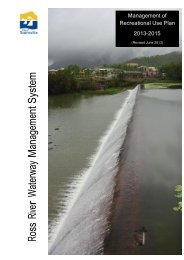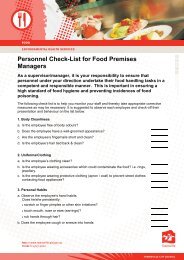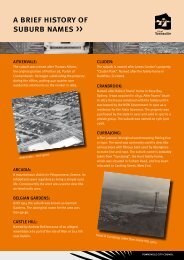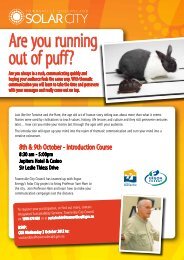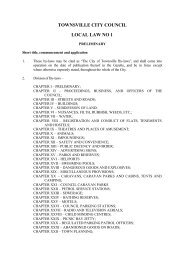STORM TIDE EVACUATION GUIDE - Townsville City Council
STORM TIDE EVACUATION GUIDE - Townsville City Council
STORM TIDE EVACUATION GUIDE - Townsville City Council
You also want an ePaper? Increase the reach of your titles
YUMPU automatically turns print PDFs into web optimized ePapers that Google loves.
What is a cyclone?<br />
A tropical cyclone is a violent collection of whirling winds and dense cloud mass. Winds spiral clockwise around a central eye of<br />
exceptionally low pressure. With winds reaching speeds in excess of 200km/h, cyclones can be extremely dangerous.<br />
What are cyclone categories?<br />
The severity of a tropical cyclone is measured by a category determine by the Bureau of Meteorology.<br />
Cyclone categories range from 1 for weaker cyclones to 5 for the most severe cyclones. This helps the community assess the<br />
severity of the cyclone and take appropriate actions.<br />
The category of a cyclone refers to the severity of winds in a maximum wind zone. You may not experience the effects of the<br />
maximum winds. Damage experienced may vary according to location factors.<br />
The category of a cyclone does not refer to an associated storm tide. Warnings for a storm tide will be issued separately by the<br />
Bureau of Meteorology (BOM).<br />
cyclone Watch<br />
A cyclone watch is issued at six hourly intervals if a cyclone or potential cyclone exists, and there is a likelihood gale force winds<br />
or stronger will affect coastal or island communities within the next 24 to 48 hours.<br />
cyclone Warning<br />
A cyclone warning is issued at three hourly intervals if gale force winds or stronger are expected to affect coastal or island<br />
communities within the next 24 hours. Warnings are updated every hour when a cyclone is close to landfall. The Standard<br />
Emergency Warning Signal (SEWS) may be used with some cyclone warnings.<br />
severe Weather Warning<br />
A severe weather warning may be issued if the system is no longer a cyclone but communities are still being threatened by<br />
damaging winds, flooding rains or pounding seas.<br />
category strongest gUst (km/h) tyPical eFFects<br />
1 Tropical Cyclone<br />
2 Tropical Cyclone<br />
3 Severe<br />
Tropical Cyclone<br />
4 Severe<br />
Tropical Cyclone<br />
5 Severe<br />
Tropical Cyclone<br />
less than 125 km/h<br />
gales<br />
125 - 164 km/h<br />
Destructive Winds<br />
165 - 224 km/h<br />
very destructive winds<br />
225 - 279 km/h<br />
very destructive winds<br />
More than 280 km/h<br />
extremely destructive winds<br />
Minimal house damage. Damage to some crops, trees and caravans.<br />
Boats may drag moorings.<br />
Minor house damage. Significant damage to signs, trees and caravans. Heavy<br />
damage to some crops. Risk of power failure. Small boats may break moorings.<br />
Some roof and structural damage. Some caravans destroyed. Power failure<br />
likely.<br />
Significant roofing and structural damage. Many caravans destroyed and<br />
blown away. Dangerous airborne debris. Widespread power failures.<br />
Extremely dangerous with widespread destruction<br />
4


